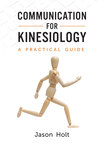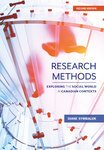We don’t actively support Internet Explorer
It appears that you are using Internet Explorer, which has been discontinued by Microsoft. Support has ended for versions older than 11, and as a result you may face security issues and other problems when using it.
We recommend upgrading to a newer browser such as Firefox, Google Chrome, or Edge for a much better experience across the web.
While this site may work with Explorer, we are not testing and verifying it, so you may run into some trouble or strange looking things.
The Craft of Qualitative Research
A Handbook
Edited by Steven W. Kleinknecht, Lisa-Jo K. van den Scott, Carrie B. Sanders
Overview
An edited collection packed with advice, exercises, and anecdotes, The Craft of Qualitative Research is a practical, introductory guide that will develop students’ skills and confidence in qualitative research. Accessible in style and tone, this text equips students with the tools needed to manage and overcome challenges, emotions, biases, and power dynamics in the field. To encourage experiential learning, 45 concise chapters include real-world examples and practical exercises from scholars and professionals in varying disciplines and stages of career. Each section begins with an editors’ introduction then takes readers through the steps of successful qualitative research: from planning projects ethically and entering the field, to collecting and analyzing data, and lastly, to exiting the field and disseminating findings. Students in research-reliant disciplines, particularly sociology, anthropology, criminology, social work, and health studies, will benefit from this distinctly practical resource.
FEATURES
- offers material accessible to both inexperienced and experienced researchers
- offers readers focused, experiential case studies exploring key stages of the research process in an in-depth fashion
Table of Contents
Preface
Introduction: Invitation to the Craft of Qualitative Research
Steven W. Kleinknecht, Lisa-Jo K. van den Scott, and Carrie B. Sanders
SECTION I: PLANNING YOUR PROJECT
Chapter 1: “The Person Behind the Research:” Reflexivity and the Qualitative
Research Process
Kalyani Thurairajah
Chapter 2: The Role of Unpredictability in Ethnographic Fieldwork
Mark S. Dolson
Chapter 3: Collateral Damage: Preparing Your Friends and Family for Your
Ethnography
Tony Christensen
Chapter 4: The Story of Dr. Charles Smith: An Exercise in Rolling Thematic
Analysis
Chris McCormick
SECTION II: NAVIGATING ETHICAL DILEMMAS
Chapter 5: Living Your Ethics: “It’s” Not Just a Dusty Document
Kerstin Roger and Javier Mignone
Chapter 6: Observing Teens: Negotiating Power and Opportunity During Field
Research
Katherine Irwin
Chapter 7: Doing Research Undercover: Interviewing Protesters
Gül Çalışkan
Chapter 8: Social Regulation and Ethics in Research
Will van den Hoonaard
SECTION III: MANAGING INSIDER/OUTSIDER STATUS WHILE GAINING ACCESS
Chapter 9: An Insider’s Perspective on Research with Policewomen in
Canada
Lesley J. Bikos
Chapter 10: Politics and Tensions of Doing Transgender Research: Lessons
Learned by a Straight-White-Cisgender Man
Matthew S. Johnston
Chapter 11: Researching Truck Drivers: Difficult Data Collection and Proving
Oneself Amidst a Culture of Suspicious Masculinity
Michael A. Fleming
Chapter 12: “You’re an Alien to Us”: Autoethnographic Accounts of Two
Researchers’ Experiences in an Organizational Setting
Cathlene Hillier and Emily Milne
SECTION IV: EXPERIENCING EMOTIONS WHILE ESTABLISHING TRUST AND RAPPORT
Chapter 13: Using a Qualitative Approach in Applied Military Personnel
Research
Justin Wright
Chapter 14: Navigating Emotions While Establishing Trust and Rapport in
Autoethnography
Colleen McMillan
Chapter 15: Personal Reputation as an “In” to Field Research Settings
Steven W. Kleinknecht
Chapter 16: “You Are Not Allowed to Be Here…”: Ethnography of Rejection, Shame, and Hurt
Thaddeus Müller
Chapter 17: Doing Research on Behind-the-Scenes Phenomena: Entering the
Female Escort Industry
Magdalena Wojciechowska
SECTION V: DOING OBSERVATION
Chapter 18: “Going Through the (E)motions”: Attending to Social Location and
Emotionality in Observational Studies of Police
Crystal Weston and Carrie B. Sanders
Chapter 19: Reconsidering Relations in the Field: Attending to Dominance
Processes in the Ethnographic Encounter
Scott Grills
Chapter 20: Minding the Gap at the Limits of Observation
Kritee Ahmed
Chapter 21: Tips and Tricks for Writing Reflexive Field Notes When Doing Team- Based Rapid Ethnographic Research
Krystal Kehoe MacLeod
SECTION VI: DOING INTERVIEWS
Chapter 22: “Show and Tell”: Using Objects as Visual Interview Guides in
Qualitative Interviewing
Kathleen Steeves and Deana Simonetto
Chapter 23: Interactional Strategies of Interview Participants and Their Sense of
Self
Deborah K. van den Hoonaard
Chapter 24: “Opening Access” to Open-Access Editors: Communication
Technologies in Long Distance Interviewing
Taylor Price and Antony Puddephatt
Chapter 25: Conducting Phenomenological Interviews
Ellen Rose
Chapter 26: A Reflection on Challenges and Negotiation in the Context of
International Fieldwork
Abhar Rukh Husain
SECTION VII: COLLECTING OTHER FORMS OF DATA
Chapter 27: Listening to Streets and Watching Paint Dry: Collecting Other Forms of Data
Deborah Landry
Chapter 28: Doing Archival Research Ariane Hanemaayer
Chapter 29: “Every Corner Tells a Story”: Using Neighbourhood Walks and GPS
to Understand Children’s Sense of Place
Bree Akesson
Chapter 30: Ethnography in Inaccessible Fields: Drawing on Visual Approaches to Understand the Private Space of the Home
Dawn Mannay
Chapter 31: Collecting Social Media Data in Qualitative Research
Meghan Lynch and Catherine Mah
SECTION VIII: ANALYZING YOUR DATA
Chapter 32: Reframing an Awkward Moment: A Comparison of Two Analytic
Strategies for Being Reflexive
Amber Gazso and Katherine Bischoping
Chapter 33: Making Sense of Your Data: From Paralysis to Theoretical
Engagement
Michael Adorjan
Chapter 34: “Dilemmas of Voice” in Community-Based HIV Research
Jeffrey P. Aguinaldo
Chapter 35: Analyzing Materiality
Carrie B. Sanders and Lisa-Jo K. van den Scott
Chapter 36: Tree Drawings: Visual Analysis and Representation of Queer Activist
Life History Research
Susan Diane
SECTION IX: LEAVING THE FIELD
Chapter 37: Leaving the Field/Can You Leave the Field?
Jeffrey van den Scott
Chapter 38: Negotiating Tensions in Exiting the Field of Critical Qualitative
Research
Sarah Benbow and Jodi Hall
Chapter 39: Leaving the Field Trajectories: Researching Hasidic Jews
William Shaffir
Chapter 40: On (Still) Being Emotionally Attached to the Field
Nichole Edwards
SECTION X: DISSEMINATING YOUR FINDINGS TO SCHOLARS AND OTHER AUDIENCES
Chapter 41: Communicating Your Ideas and Publishing Readable Texts
J. I. (Hans) Bakker
Chapter 42: Dissemination and Social Justice
Snežana Ratković and Bharati Sethi
Chapter 43: Promoting Qualitative Research in the Public Sphere: Lessons Learned from Online Criticisms
Chad Walker
Chapter 44: After the Fine Cut: Disseminating Video-Based Research
Sarah Abbott and Phillip Vannini
Chapter 45: Disseminating Qualitative Research in Media
Christopher J. Schneider
Contributors
Index









